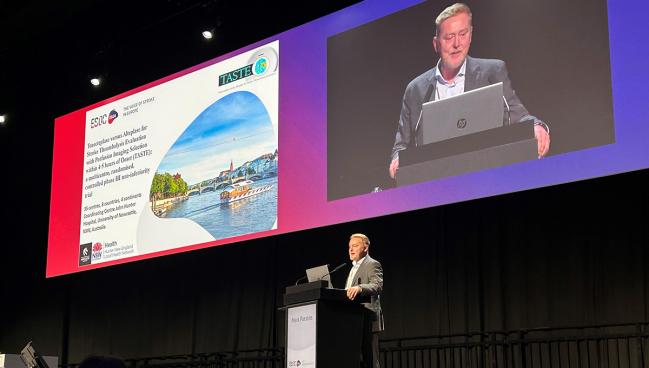More Trial Evidence Supports Tenecteplase for Acute Stroke Thrombolysis
“It’s getting harder and harder to justify a group where alteplase would be preferred,” Seemant Chaturvedi says.

Two trials—TASTE and ORIGINAL—provide additional evidence for treatment within the first 4.5 hours after stroke onset, with TRACE-III indicating that tenecteplase can improve functional outcomes among patients who present beyond that time point and don’t have ready access to endovascular thrombectomy.
These new trials join several previous ones—including AcT and TRACE-2—showing that tenecteplase provides clinical outcomes that are at least as good as those obtained with alteplase, the longtime standard of care for stroke thrombolysis, in patients with moderate-to-severe acute ischemic strokes. But tenecteplase, a molecular cousin of alteplase, brings with it some advantages, including greater fibrin specificity and a longer half-life, which allows for more convenient administration as a single bolus rather than delivery as a 1-hour infusion.
Mark Parsons, MD, PhD (University of New South Wales, Sydney, Australia), who presented the TASTE results at ESOC 2024, said that for treatment within the first 4.5 hours after stroke onset, “the chapter’s pretty much closed now on the first-choice thrombolytic. It should be tenecteplase.”
For the late treatment window, however, “there’s probably still a bit of research to be done before there’s complete practice change,” Parsons added. He noted that the TIMELESS trial failed to show a significant benefit of tenecteplase in the late window, but pointed out that most patients ultimately were treated with mechanical thrombectomy, and relatively shortly after receiving IV thrombolysis. TRACE-III, on the other hand, focused on patients who didn’t have timely access to mechanical thrombectomy, and showed a benefit of treatment with TNK.
“The Chinese TRACE-III findings are actually broadly generalizable to virtually all low-to-middle-income countries,” where access to endovascular thrombectomy is much lower than in higher-income countries or is nonexistent, Parsons said.
“If you’ve got access to endovascular thrombectomy, even if it’s delayed, the patient should still be transferred for that. That’s definitely the standard of care,” he stressed.
The TASTE Trial
The phase III TASTE trial was performed at 35 centers in Australia, New Zealand, Taiwan, Europe, the United Kingdom, and Canada, with enrollment spanning the release and integration into practice of the positive trials of mechanical thrombectomy as well as trials establishing the noninferiority of tenecteplase versus alteplase. Ultimately, after adjustments that included a switch from a superiority to a noninferiority design and a smaller-than-expected sample size due to an early stoppage, the investigators randomized 680 participants (median age about 74 years; 62% men). Median NIHSS score was 7, with about one-third of patients having a large-vessel occlusion (LVO). Median ASPECTS was 10.
All patients, who were not candidates for endovascular therapy, were selected based on perfusion imaging showing salvageable brain tissue within 4.5 hours of symptom onset. They were randomized to IV alteplase at a dose of 0.9 mg/kg or tenecteplase at a dose of 0.25 mg/kg. The median time from stroke onset or when they were last known to be well to administration of the thrombolytic was about 2.5 hours.
The primary outcome was the proportion of patients with a modified Rankin Scale (mRS) score of 0 to 1, indicating no disability, at 3 months. In the intention-to-treat analysis, this was 57% with TNK and 55% with alteplase, with a standardized risk difference of 0.03 (95% CI -0.031 to 0.10). Because the lower bound of the CI was not above -0.03—“missed by a mouse’s whisker,” Parsons said—the analysis failed to establish the noninferiority of tenecteplase. The difference in the per-protocol analysis, however, did meet criteria for noninferiority, with a standardized risk difference of 0.05 (95% CI -0.02 to 0.12).
The chapter’s pretty much closed now on the first-choice thrombolytic. It should be tenecteplase. Mark Parsons
When the TASTE results were placed into a study-level meta-analysis of published phase II and III trials of TNK, there was a significantly greater chance of achieving an mRS score of 0 to 1 at 90 days with tenecteplase than with alteplase, with a number needed to treat (NNT) of 25, Parsons reported.
TASTE, Parsons said, is the largest clinical trial to use perfusion imaging selection in all patients and the only trial to require inclusion of patients with a proven tissue target for reperfusion treatment, “which is the main advantage of [CT perfusion] selection and a unique contribution of TASTE to the data.
Overall, “TASTE increases our confidence that tenecteplase is at least noninferior to alteplase for stroke thrombolysis in the early time window” and “will continue and accelerate practice change and ongoing implementation of tenecteplase as the first-choice thrombolytic for disabling ischemic stroke,” Parsons said.
Indeed, commented Seemant Chaturvedi, MD (University of Maryland School of Medicine, Baltimore), this trial is “sort of icing on the cake because many centers have already switched” to tenecteplase based on the results of other studies. He added that if the NNT of 25 calculated from the meta-analysis is true, “then I think that’ll encourage some of the remaining centers who haven’t made the switch yet that it’s safe and reasonable to convert to tenecteplase.”
Ultimately, Chaturvedi said, “it’s getting harder and harder to justify a group where alteplase would be preferred,” except in areas that are experiencing ongoing shortages of tenecteplase. “If a center is continuing with alteplase, that is probably reasonable,” he allowed, “but considering the advantages of the bolus dose and the ease of administration, ease of use for the emergency room nurses, I think a lot of factors would favor tenecteplase.”
The ORIGINAL Trial
Later in the meeting, Shuya Li, MD (Beijing Tiantan Hospital, Capital Medical University, China), presented the results of the ORIGINAL trial, a phase III study designed to support regulatory approval of tenecteplase for acute stroke in China. At 55 sites across the country, investigators randomized 1,489 patients (mean age 65 years; 30% women) who presented with 4.5 hours of stroke onset to receive tenecteplase or alteplase. The mean NIHSS score at baseline was 7, and 8% of patients ultimately underwent thrombectomy.
The primary outcome was the proportion of patients with an mRS score of 0 to 1 at 90 days, with 72.7% of tenecteplase-treated patients and 70.3% of alteplase-treated patients meeting that standard (adjusted risk ratio 1.0278; 95% CI 0.9678-1.0915). With the lower bound of the CI exceeding 0.937, tenecteplase was noninferior to alteplase. The primary outcome consistent favored TNK across subgroups.
There were no differences between trial arms for other efficacy endpoints, including major neurological improvement at 24 hours or mRS score 0 to 2, Barthel Index score, or mean change in NIHSS score at 90 days.
The rate of symptomatic intracranial hemorrhage was not significantly different between groups, irrespective of the definition use. Using ECASS III criteria, for example, the rate was 1.2% in both arms. There also were no differences between the TNK and alteplase arms in the rate of all-cause mortality at 90 days (4.6% vs 5.8%) or serious adverse events (15.8% vs 15.6%).
“The findings of this study are consistent with those of previous trials, such as AcT and ATTEST-2, providing additional evidence for tenecteplase as a promising alternative to alteplase for acute ischemic stroke,” Li said.
Treating in the Late Window in TRACE-III
The TRACE-III trial, also conducted in China, examined use of tenecteplase among patients with acute ischemic strokes caused by LVOs who presented 4.5 to 24 hours after stroke onset, with selection guided by perfusion imaging. The trial differed from TIMELESS, in which 77% of patients underwent mechanical thrombectomy, in that it focused on patients who were not planned for endovascular therapy.
Yunyun Xiong, MD, PhD (Beijing Tiantan Hospital, Capital Medical University, China), in introducing TRACE-III, noted that access to thrombectomy is very low using a global lens—just 2.79% around the world.
The investigators randomized 516 patients (mean age about 67 years; 68% men) who presented in the late time window and had salvageable brain tissue on perfusion imaging to tenecteplase or standard medical treatment, which consisted of aspirin, clopidogrel, or dual antiplatelet therapy. Median NIHSS score at admission was 10-11, and the time from symptom onset to randomization was just over 12 hours.
The primary outcome in TRACE-III also was the proportion of patients with an mRS score of 0 to 1 at 90 days—this was 33.0% with tenecteplase and 24.2% with antiplatelet therapy (relative risk 1.37; 95% CI 1.04-1.81).
TNK also had an advantage in terms of the proportion of patients with an mRS score of 0 to 2 at 90 days, early neurological recovery at 72 hours, reperfusion > 90% at 24 hours, and early improvement in NIHSS score.
Though the rate of symptomatic intracranial hemorrhage was numerically higher in the tenecteplase arm (3.0% vs 0.8%), it was comparable to rates in prior trials, including TIMELESS and studies of treatment in earlier time windows. There were no significant differences between arms in 90-day mortality, severe or moderate systemic bleeding, or serious adverse events.
“The results apply to patients who cannot immediately access thrombectomy, including those requiring interhospital transfer in whom there is no guarantee they will remain eligible for endovascular treatment on arrival,” Xiong said.
Agreeing was Eva Mistry, MBBS (University of Cincinnati, OH), who said the results would not apply to the US and other parts of the world where patients have access to timely mechanical thrombectomy.
“But I think it’s an important trial that shows us that TNK helps lyse big clots. Mechanistically, that makes sense,” Mistry said, adding that in TIMELESS, the impact of tenecteplase was diluted by the effects of thrombectomy.
These results may be applicable to areas with better access to thrombectomy for “drip-and-ship” patients who require a transfer to a comprehensive stroke center for the procedure, particularly those with longer delays to treatment.
“But I would not delay transfer for this,” Mistry said. “I wouldn’t do anything differently other than making a case that, ‘Well, I can now give them TNK in addition to doing everything else I was to get them ready for thrombectomy.’”
Parsons noted that he’s involved in a trial called ETERNAL-LVO that is exploring use of tenecteplase in the extended time window for patients with LVO strokes who are eligible for thrombectomy. “I still think in the late time window, there is going to be potentially a benefit of giving tenecteplase if there’s going to be a delay in patients getting to thrombectomy,” he said.
Todd Neale is the Associate News Editor for TCTMD and a Senior Medical Journalist. He got his start in journalism at …
Read Full BioSources
Parsons MW. Tenecteplase versus alteplase for stroke thrombolysis evaluation with perfusion imaging selection within 4.5 hours of onset (TASTE): a multicentre, randomized, controlled phase III non-inferiority trial. Presented at: ESOC 2024. May 15, 2024. Basel, Switzerland.
Li S. ORIGINAL: a phase III, multicentre, prospective, randomized, open-label, blinded endpoint (PROBE), active-controlled, parallel-group trial to assess the efficacy and safety of tenecteplase versus alteplase in Chinese patients with acute ischaemic stroke within 4.5 hours after stroke onset. Presented at: ESOC 2024. May 16, 2024. Basel, Switzerland.
Xiong Y. Tenecteplase for ischemic stroke due to large vessel occlusion at 4.5 to 24 hours with perfusion imaging selection. Presented at: ESOC 2024. May 16, 2024. Basel, Switzerland.
Disclosures
- TASTE funded by a government grant from the National Health and Medical Research Council of Australia, with additional funding and some study drug provided by Boehringer Ingelheim.
- Parsons reports serving on a Boehringer Ingelheim advisory board for tenecteplase (Metalyse) in stroke.
- ORIGINAL was supported and funded by Boehringer Ingelheim (China) Investment Co., Ltd. Boehringer Ingelheim Pharma GmBH & Co KG manufactured and provided tenecteplase.
- Li reports no relevant conflicts of interest.
- TRACE-III was funded by the National Natural Science Foundation of China and the Beijing Municipal Science & Technology Committee, with tenecteplase provided by the China Shijiazhuang Pharmaceutical Company Recomgen Pharmaceutical (Guangzhou).





Comments